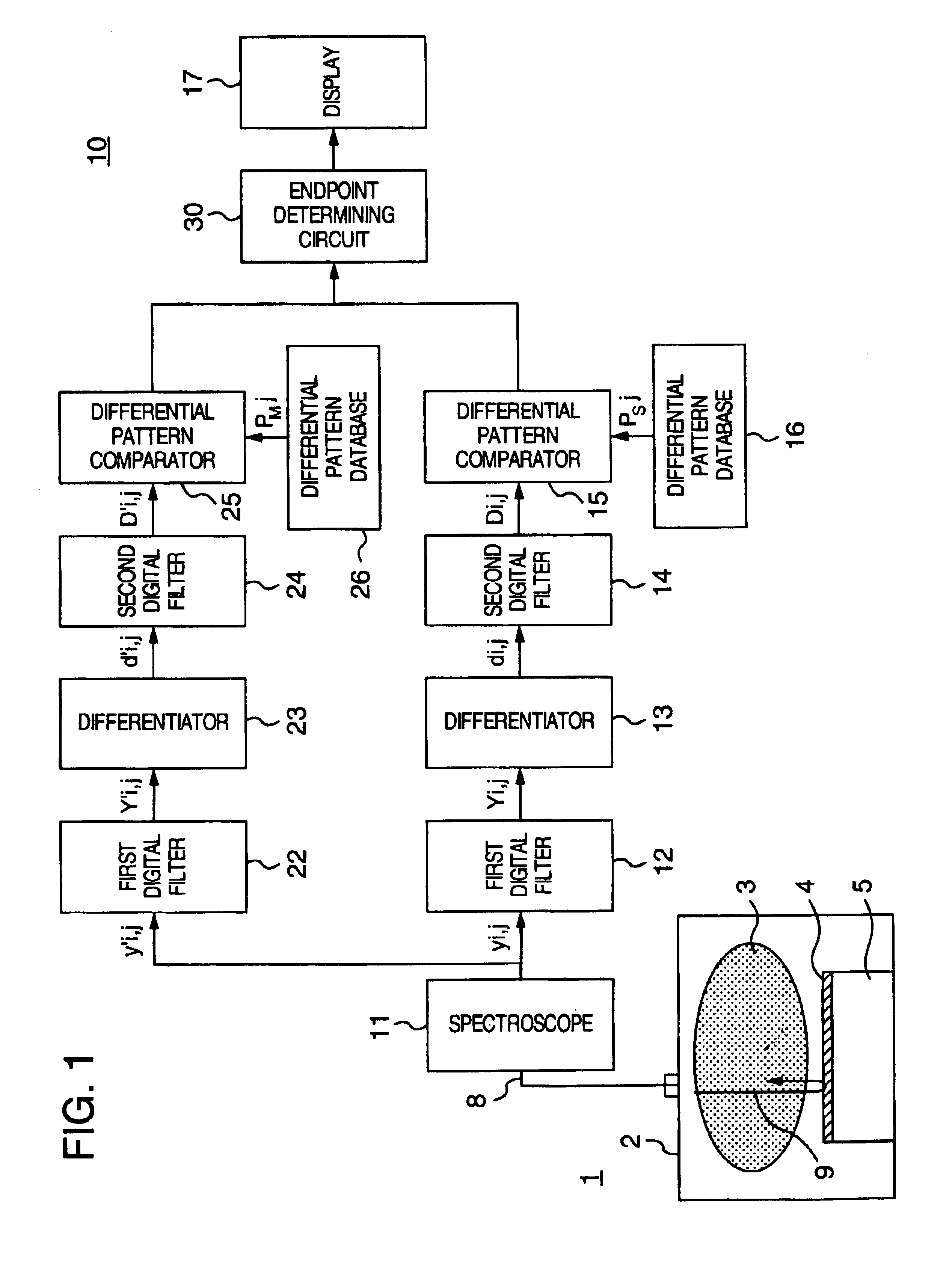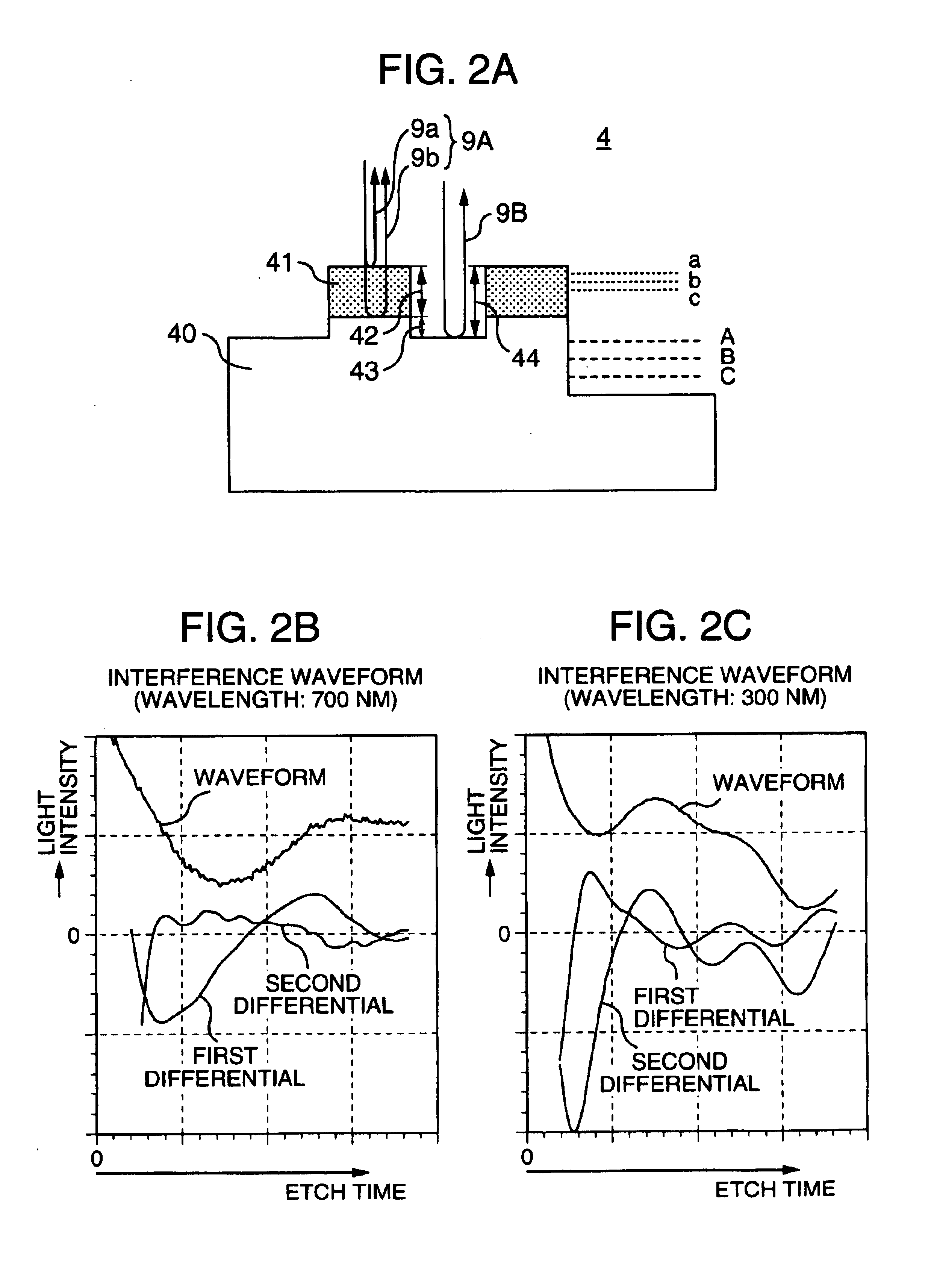Method and apparatus for determining endpoint of semiconductor element fabricating process
a technology of semiconductor elements and endpoints, which is applied in the direction of semiconductor/solid-state device testing/measurement, instruments, electric discharge tubes, etc., can solve the problems of low reproducibility in terms of thickness, the inability of time monitor techniques to accurately measure the actual final thickness of the siosub>2 /sub>layer remaining on the silicon substrate, and the inability of endpoint determining units to reliably determine the endpoint of the etching process based on the sampl
- Summary
- Abstract
- Description
- Claims
- Application Information
AI Technical Summary
Benefits of technology
Problems solved by technology
Method used
Image
Examples
first embodiment
[0054]Embodiments of the present invention will be described. In the following embodiments, constitutional members with similar functions to those of the first embodiment carry like reference numbers and their detailed descriptions are omitted. As the endpoint determining method used in the semiconductor device manufacturing process according to the present invention, we will describe a method of measuring an etch quantity (etched depth and film thickness) in a wafer etching process. It should be noted that the present invention is not limited to this method and can also be applied to a method of measuring an amount of deposition (deposited film thickness) or the like in such film deposition processes as plasma CVD and sputtering.
[0055]Now, a first embodiment of the present invention will be described by referring to FIG. 1 to FIG. 4.
[0056]In this embodiment, when plasma etching is to be performed on a material to be processed such as a semiconductor wafer, standard patterns PS and ...
second embodiment
[0090]Next, the present invention will be described by referring to FIGS. 8, 9, 10 and 11. The configuration of this embodiment shown in FIG. 8 is identical with the configuration 11-19 of FIG. 5 for one wavelength band and the operation of the endpoint determining circuit 130 is different from that of the endpoint determining circuit 30 of FIG. 5. The structure of the material to be etched is shown in FIG. 9. The area of a polysilicon 50 processed by this etching process lies where there is no mask layer 51 (e.g., nitride film and photoresist). The observed interference light is produced by the interference between light 90A reflected by the surface of the polysilicon 50 and light 90B reflected by an underlying oxide film 52. A method of measuring the etch quantity (remaining thickness 53: thickness of polysilicon measured from the underlying oxide film) by measuring the interference light will be explained with reference to the flow chart of FIG. 10.
[0091]First, a target remaining...
third embodiment
[0098]Next, the present invention will be described by referring to FIG. 12 and FIG. 13. In controlling the etch depth, this embodiment determines the etch depth from the initial film thickness and the measured remaining film thickness because wafers have errors in the thickness of an organic film. The configuration shown in FIG. 12 is the same as the configuration 11-19 of FIG. 8 and the operation of the endpoint determining circuit 230 differs from that of the endpoint determining circuit 130 of FIG. 8. The structure of a material to be etched is shown in FIG. 13. The area of an organic film 60 to be etched (groove structure) lies where there is no mask layer 61 (e.g., nitride film and photoresist). The interference light observed is produced by interference between light reflected by the surface of the organic film and light reflected by an interconnect layer 62 (e.g., Cu).
[0099]The method of measuring an etch quantity (groove depth 65: distance between D and E) by measuring the ...
PUM
 Login to View More
Login to View More Abstract
Description
Claims
Application Information
 Login to View More
Login to View More - R&D
- Intellectual Property
- Life Sciences
- Materials
- Tech Scout
- Unparalleled Data Quality
- Higher Quality Content
- 60% Fewer Hallucinations
Browse by: Latest US Patents, China's latest patents, Technical Efficacy Thesaurus, Application Domain, Technology Topic, Popular Technical Reports.
© 2025 PatSnap. All rights reserved.Legal|Privacy policy|Modern Slavery Act Transparency Statement|Sitemap|About US| Contact US: help@patsnap.com



